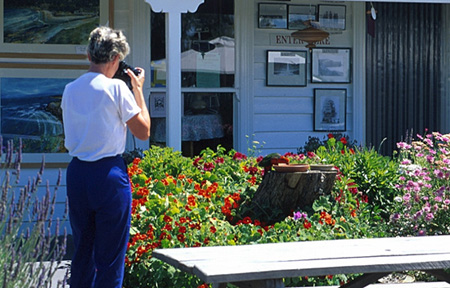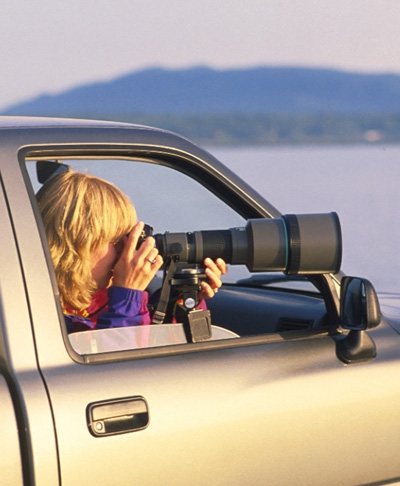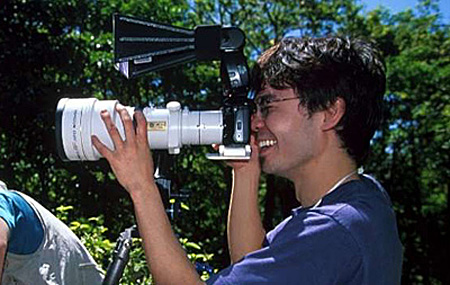
Here are some thoughts for Bill Horm, Oklahoma’s premier bird photographer.
Backyard Bird Photography
You might be surprised at how easy it is to approach backyard birds, especially if they are accustomed to seeing people in the yard while they feed or bathe.
Practice easing into position close to your feeders and remain still until the birds return. Bird photography is both fun and challenging, but it requires a modicum of patience. Learn to judge light and use it to your advantage. Morning and evening light is soft and pleasing to the eye as opposed to harsh mid-day sunlight.
In open shade, use an electronic flash. If possible, turn it down just a bit from full power and use it to fill in shadow areas and provide a “catchlight” in the bird’s eye. Be conscious of getting distracting background clutter in your photographs. Often, just one step to the left or right may yield a smooth, colorful background.
Compose the bird; leaving room for him to look, fly or walk into the picture without being cramped in the frame. A songbird is a small target, so practice working in as closely as possible to your subject. Do not become discouraged if at first you do not produce many good images. The more experience you have the better your images will turn out.

This lady has a very unusual subject to photograph but photographing the birds you see in your back yard can be fun and may be easier than you think.
Professional bird photographers use a variety of techniques and tricks, and you can apply some of them in your own backyard. Strategically place your feeders and birdbath close to bushes and trees, behind which you can hide. Place carefully selected natural landing perches, such as a potted shrub with red berries near them, and catch the birds as they light on the perches before they head to the food or water. Use a blind or natural lean-to to break up your silhouette.
Avoid fast, jerky movement, and if you must move, take short, slow steps. Watch your nesting birds and note when they begin bringing food back to the nest site. Without disturbing the birds or in any way disrupting their activity, hide somewhere along the return path.
You will be rewarded with images of parents with prey and, in some cases, parents feeding fledglings near the nest. Never remove vegetation to photograph birds at a nest, as such action may allow too much sunlight or predators to reach the nest – either can be fatal to young birds.
Backyard bird photography is a rewarding personal experience, and it indirectly serves to benefit nature. Providing habitat, housing, food and water to the birds in your yard is more than a benevolent gesture. It fosters a sense of sharing, encouragement to improve our natural environment, and compassion for animals.
And besides, it is just plain fun!
Lighting conditions
No doubt, understanding light is among the most difficult challenges that photographers face. We primarily use two light sources to expose images. Ambient or available sunlight is normally the prime source. The other is flash and is provided by flash units. In all cases, either one or the other is used. The next section deals with combining them.
Ambient light serves us well for most outdoor shooting. The most common mistake amateurs make is shooting in harsh, direct sunlight, say from 11:00 a.m.- 4:00 p.m. During that time the sun, if unobstructed by clouds, is too direct, and the result is too much contrast and washed out color.
The ideal time to shoot outdoors is either early or late or on a slightly hazy day. The “magic hour” occurs just after sunrise and before sunset when light is soft and color is fully saturated. Also, that is the time when birds are most active, scurrying to gather food. Have you ever seen a television ad for a car filmed in direct sun? Nope. Notice next time – – they are filmed under late or hazy skies or just after a rain, so the colors will be bright and saturated.
Read also: Digiscoping birds
The same holds true for birds or any other subject. Occasionally we are forced to shoot under bright, sunny skies, and there is a way to get good images in bright sunlight. Use of a polarizing filter will take out annoying reflections and saturate otherwise washed out colors. Don’t hesitate to use your flash outdoors especially in the shade.
Fill-Flash
Learning how to effectively use fill-flash will dramatically enhance your bird images.
Why?
Because in a lot of cases, birds are in trees or other shaded areas out of direct sunlight. The indirect lighting often actually increases color saturation in feathers, but we need to fill in the shadow areas.
How do you do that? You use your flash unit. Some of them can be set to automatically fill shadows, while others must be set manually. Consult the manual for your individual unit. The manually set flash is best for a number of reasons.
- When you want the fill-flash at less than one-to-one with the ambient light.
- Depending on conditions, vary the amount of fill.
- Relying on automatic fill can be disastrous if your light meter gets fooled under difficult lighting conditions.
Advanced flash units will allow you to set fill at +/- 1/3 increments. Under normal conditions, set it somewhere between minus 1 to 1 1/3 EVA. That means the flash is underexposing by up to 1 1/3 f-stop. The effect you are trying to achieve is an image that does not look “flashed.” Another plus is in many cases fill-flash will put a catch-light in the bird’s eye. The difference in fill-flash and no fill-flash can be dramatic.
Long lens technique
This is for those fortunate enough to have lenses in the 400mm and up class. These lenses are, large, heavy, and require a great deal of practice in order to get good images. The learning curve is steep, but just about anyone can master it with a little training and practice.

If you take your photography on the road your car will make an excellent blind.
Window mounts can be used for the steady aim the long lenses require.
The gremlins that ruin our images such as equipment shake are multiplied several times over with super teles. For birds, you need all the lens length you can afford, and learning to use one is not an insurmountable task. A sturdy tripod and good ball head are a must. Most shots are of semi-static birds, and this is where technique comes into play.

Big lenses require a good tripod for the desired results.
Long lenses are prone to blurring images due to mirror flop. Vibrations travel along the lens and can cause problems with shutter speeds below 1/500 second. Position your face firmly against the viewfinder and place your hand on top of the lens during exposure to minimize if not eliminate vibration.
Some use an electronic shutter release with big lenses, but others find them too much trouble to use and not all that effective. Be sure that tripod legs are tight and secure before mounting your lens. You don’t want to embarrass yourself by dropping a $10,000 piece of glass. Work with the controls on the head slightly snug but moveable.
With practice it becomes second nature. You have to find the right balance between too tight and loose. A tight head reduces the chance of blur, but some movement is required when trying to locate a small, moving bird in the viewfinder.
If it is too loose, lens flop can ruin your day and your lens.
Digiscoping Birds
Digiscoping is bird photography that combines the magnifying power of a spotting scope with a digital camera.
Digiscoping has become a very popular method for taking photographs of birds. The technique involves marrying a digital camera to a spotting scope. The combination provides extreme magnification for photographing distant birds. When using top quality spotting scopes (prices can range from about $2000 to almost $5000) the quality of the resultant images can be little short of spectacular. Many digital cameras can also capture video, a feature that can also be used when digiscoping.
Several of the top spotting scope manufacturers have posted video clips on YouTube that demonstrate the technique.
Zeiss – setting up the adaptorhttps://www.youtube.com/watch?v=S0qY-Lc6yjo
Taking your first digisscoped image
Choosing a camera for digiscoping
Setting up the Swarovski Digital Camera Adapter
Contribute to this section
If you would like to contribute your tips and techniques for bird photography, just drop us a line. We’ll post the selected tips and provide a link to your web site.

